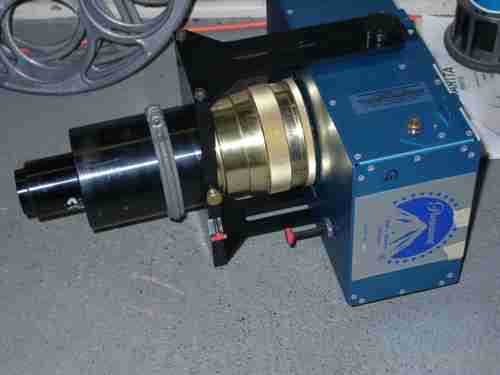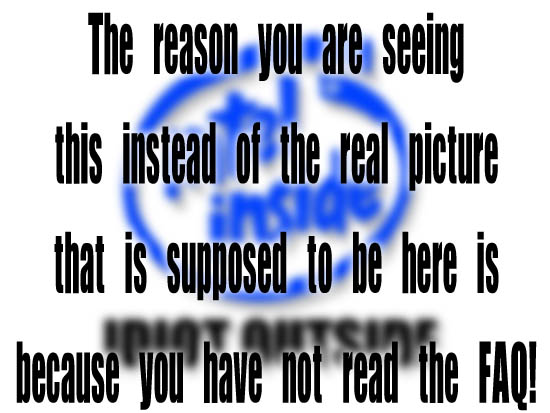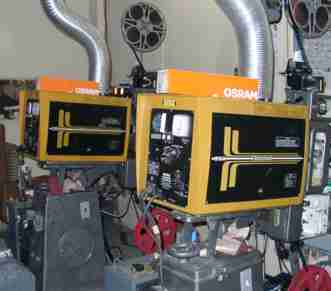|
|
This topic comprises 2 pages: 1 2
|
|
Author
|
Topic: Classic 50s 3-D converted to IMAX 3-D – a good or a bad idea
|
|
|
|
|
|
|
|
|
|
|
Stephen Furley
Film God

Posts: 3059
From: Coulsdon, Croydon, England
Registered: May 2002
|
 posted 04-28-2007 04:55 AM
posted 04-28-2007 04:55 AM




quote: Mark Gulbrandsen
The best 3-D I've seen from older stuff is by far "House Of Wax". I've seen it both in 2-projector 35mm and in the old side by side 70mm format. Both are outstanding ways to see it, single strip 35mm sucks big.
I saw it maybe ten years or so ago, on a two strip print that was fairly new at the time. It's kept permanenty made up on four 6k spools. I've also 'seen', in the sense of looked at a reel of it on the bench, a reel of the 35mm side by side anamorphic format re-release version; that print was very dark for some reason. I've never seen any print projected in this format, but I did once visit the box at the NFT when they had run 'The Stewardesses' in this format the previous evening and they still had the optics there. Even just looking through them there seemed to be a considerable light loss, so I would imagine that the re-issue print of 'house of Wax' would have looked pretty bad. Why the print was so dark in the first place, and whether all prints, or even all reels of the same print, were the same, I don't know.
I didn't know that it had been released in 70mm side by side, but this always struck me as being a good format to release the older Academy ratio 3-D films in. There are more cinemas with 70mm projectors than interlocked pairs of 35mm ones, it's far easier to set up, you don't have to cut the other print to match, or insert slugs , if the odd frame is lost, and since both frames on the print are exposed and processed together they should be better matched in density and colour balance.
I've seen several films in the 35mm 'under and over' widescreen process; I think it looks ok on smaller screens, maybe up to about 8 metres, maybe 10 if you push it, but it's not good on large ones. I don't think any of the films I've seen in the process was much good, but that's a different matter. What would be the best way to do widescreen 3-D on 70mm? There would seem to be two options, 10-perf with two full sized 5-perf frames under and over, or 5-perf with two anamorphic frames side by side. The 10-perf option should be good, but there would be very few places that could run it, could be suitable for a 'special venue' though. Has either of these formats actually been used anywhere. What about two wide frames, under and over, in a standard Imax frame area; has anybody done that?
I've even seen two strip on 16mm, shown on a pair of B+H 609s mechanically interlocked via a timing belt running on pulleys fitted to the ends of the motor shafts. It was somebody's home movie, shot with a pair of Bolex H16s, I don't know how he interlocked them. There were problems due to the length of the belt, it tended to stretch somewhat, so he had to fit a couple of idler rollers on each machine to keep it in place on the pulleys and stop it slipping round a notch, but it worked. Nice bright picture, about six feet wide, from the two carbon arcs!
quote: Mark Gulbrandsen
Amazingly it was directed by a one eyed director who couldn't see in 3-D.
Yes, strange that. I met him briefly once, after an on-stage interview at the NFT.
| IP: Logged
|
|
|
|
|
|
|
|
|
|
|
|
Stephen Furley
Film God

Posts: 3059
From: Coulsdon, Croydon, England
Registered: May 2002
|
 posted 04-29-2007 05:27 AM
posted 04-29-2007 05:27 AM




quote: Bobby Henderson
There are some disturbing parallels between what is happening to IMAX and the way 5-perf 70mm was all but transformed into a mere blow-up format for 35mm movies. Once digital sound was developed for 35mm, we saw 5/70 all but disappear. Some bean counter will probably come along with a 2K digital projector outfitted with a 15,000 watt lamp house and say that's just as good as IMAX. And there's probably enough idiots out there who will get bowled over by that "digital" buzzword and believe the claim.
Yes, I agree.
quote:
Single strip 35mm (Anamorphic side by side) Can look excellent. Unfortunately it was never commercially presented that way. First you had those awful coke bottle split lenses & polarizers behind a Bausch & Lomb Scope attachement of dubious worth preceded by a generally underpowered lamphouse (Even for Flat!). I ran HOW Single Strip 35mm for a Stereoscopic symposium about 6 years back. My Silver screen (1:37) was 18 ft wide. I used a Kinoton projector & lamphouse with a 4K bulb & the current just about buried. A Schnieder compact anamorphic into a modified Mirror box & polarizer. The image was stunning. Again, you'd never see such an overkill in a commercial theatre but thats what it takes to light those single strip prints up. [Big Grin]
That's the problem; it's almost impossible to get enough light on the screen with this system in any normal cinema. Very similar to the 16mm two strip that I saw, and help set up and run; that looked good, but where would you normally be able to find two carbon arcs, running at the maximum current the 609 rectifiers could provide, something like 35A, on a screen of less than two metres? What can be specially set up for a demonstration and what you can reasonably do in a normal cinema, at reasonable cost are rather different things.
Just out of interest, was the print that you had dark, like the odd reel that I saw?
Bob Furmanek always stresses the superiority of the two-strip system, but much as I hate to disagree with Bob, I think that if we're going to see 3-D, on film, back in cinemas it's going to have to be mainly on some sort of single strip format. Peter Apruzzese runs two-strip 3-D from time to time at the Lafayette in Suffern NY, and when I last spoke to him in May last year he was talking about running some of the later single strip under and over widescreen titles. I've never seen 3-D there, but it should look very good. The auditorium is the right shape for it, the projection is almost level, I could see no hot-spotting on his screen, I didn't even realise that it was silver when I first saw it, and the screen size while fairly small is towards the upper end of what would be reasonable for this format. I don't know what lamps he is running, but his screen illumination on normal 2-D films is very bright, and uniform.
Of course, for the later films you generally don't have a choice; they were filmed, and only ever released in, a single-strip format. I still think it's a shame that the 70mm side by side non-anamorphic format wasn't more widely used for re-release of the original '50s Academy ratio two-strip films. For the later widescreen titles there's a third possible 70mm option that I didn't think of yesterday; side by side, as above, but anamorphic. I don't think that's ever been used, but I can't see any reason why it couldn't be. There are plenty of cinemas with 70 mm projectors which haven't run that gauge for years, if ever. It could be worth giving it a try in a few places. You'd probably need a new screen; the few silver ones which are still installed are generally in poor condition.
It's also a shame that the original magnetic stereo tracks for 'House of Wax', and I believe other original '50s 3-D films, and the 1951 Festival of Britain shorts are no longer available.
| IP: Logged
|
|
Frank Angel
Film God

Posts: 5305
From: Brooklyn NY USA
Registered: Dec 1999
|
 posted 04-29-2007 01:19 PM
posted 04-29-2007 01:19 PM





quote: Mark Gulbrandsen
Hitch filmed it pretty much as though it were a 2-D film... there is only that part where the arm comes out of the screen at you with the scissors. In fact Dial M was released in majority when 3-D had gone into decline and most theaters showed Dial M in 2-D.
Yah, but Mark, that is the beauty of DIAL M -- it was filmed as a regular movie....no gimmiky crap being thrown at you, nothing that said, "look, ma, it's 3D." HOUSE was the same way. Both were just really good films with a good story that had the added visual depth -- and that added dimension, like color is a great way to experience a film, IMHO.
If more of the 3D films took this approach, people wouldn't have look at it as a just a fad as much as they did. I mean, let's face it, most of the films that were shot during those four 3D years were no classics; most, in fact, were forgetable. Most were basically "B" movies that relied on the 3D effect to make them entertaining. How much crap being thrown at you by bad actors mouthing corny lines in uninteresting stories can you watch without getting bored?
Had 3D become just another tool like color, rather than an end in itself, and used by really good directors like Hitch, better quality films and maybe more of them might have come out of that era. DIAL M seems to be an example of the better way to use stereography, not the worst. Maybe it was because DeToth DIDN'T see in 3D is why HOUSE works so well -- he wasn't exagerating what he couldn't see!
| IP: Logged
|
|
|
|
Ramon Lamarca Marques
Expert Film Handler
Posts: 186
From: Edgware, England, UK
Registered: Feb 2006
|
 posted 05-01-2007 04:12 PM
posted 05-01-2007 04:12 PM




quote: Stephen Furley
Bob Furmanek always stresses the superiority of the two-strip system, but much as I hate to disagree with Bob, I think that if we're going to see 3-D, on film, back in cinemas it's going to have to be mainly on some sort of single strip format.
It is an amazing system indeed. This is why I suggested IMAX DMR because of it being a two-strip system it would be closer to the original spirit than any digital or single strip re-release. The Mad Magician has got some charm and nice stereoscopic photography in black and white. As I said, Inferno looks very well in two-strip. I think I was probably lucky enough to see a dye transfer print/s of Inferno, the colours look gorgeous, Technicolor comes out of the screen without 3-D, imagine with 3-D ![[thumbsup]](graemlins/thumbsup.gif)
| IP: Logged
|
|
|
|
All times are Central (GMT -6:00)
|
This topic comprises 2 pages: 1 2
|
Powered by Infopop Corporation
UBB.classicTM
6.3.1.2
The Film-Tech Forums are designed for various members related to the cinema industry to express their opinions, viewpoints and testimonials on various products, services and events based upon speculation, personal knowledge and factual information through use, therefore all views represented here allow no liability upon the publishers of this web site and the owners of said views assume no liability for any ill will resulting from these postings. The posts made here are for educational as well as entertainment purposes and as such anyone viewing this portion of the website must accept these views as statements of the author of that opinion
and agrees to release the authors from any and all liability.
|

 Home
Home
 Products
Products
 Store
Store
 Forum
Forum
 Warehouse
Warehouse
 Contact Us
Contact Us




 Printer-friendly view of this topic
Printer-friendly view of this topic








![[Big Grin]](biggrin.gif)




![[puke]](graemlins/puke.gif)



![[thumbsup]](graemlins/thumbsup.gif)



